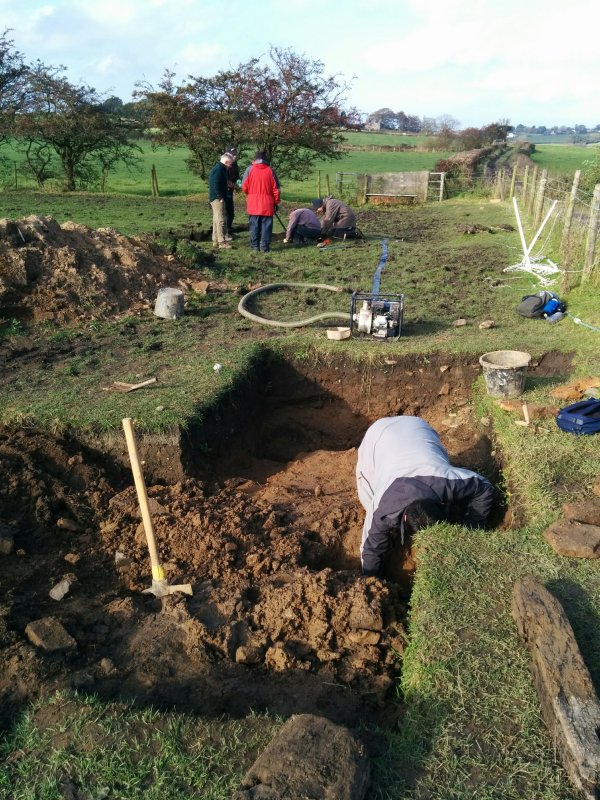Date: 20th November 2019
Hopefully our last visit to this site for the year (getting too cold to be out) and again our usual four in attendance (Patrick was apparently in Norwich this week). Anyway the main task at hand was to finish off the back filling and re-turf. However we spared one of us (Chris) to have one last go at ‘Patrick’s mound’ to see if anything structural could be detected, before this too had to be back filled. Excavating the apparent feature on north side of the trench however, Chris could only reveal a shallow scoop in the soft sandy clay bank, which was filled with loose stones. 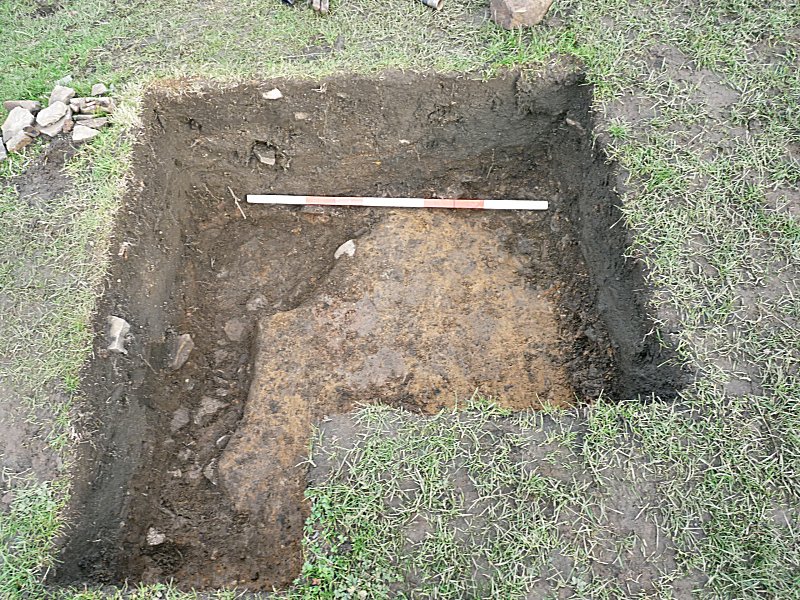
A section cut through the clay bank only revealed more clay and loose stone. Nothing structural could be detected – it just looked like a dumping ground for small stones and clay.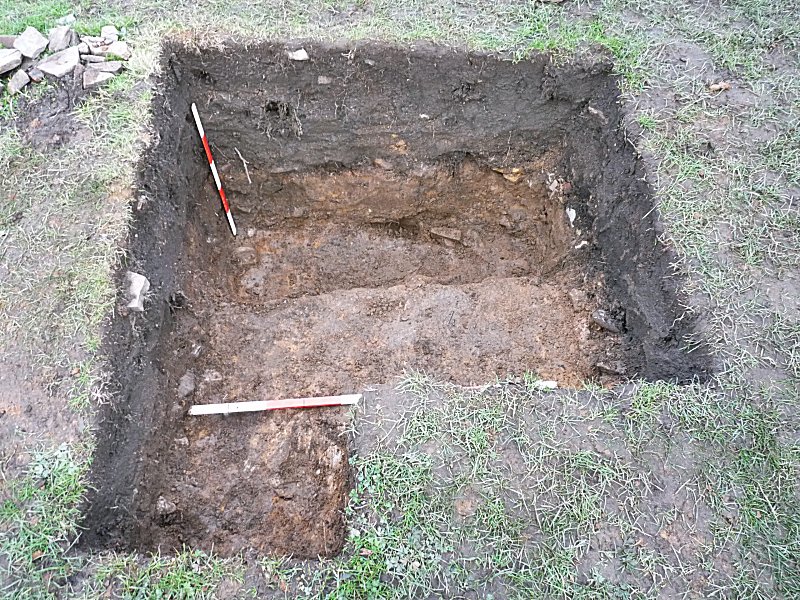 Eventually, towards the end of the day, with time running out and all the potential features explored, we were left with what appeared to be clay infill mixed with loose stones. This is perhaps not too surprising as the location is on alignment with field drain which must have required a trench to install it. There are other surface features in this area such as a line of stones exposed on the surface running close to the fence line but this is most likely the result of disturbance over the years due to roadway maintenance (it should also be remembered that a large mains water pipe has been installed along the track edge). I’m fairly sure we have gained as much as we can from this site now which has kept us entertained throughout the summer but next season we’ll be looking elsewhere.
Eventually, towards the end of the day, with time running out and all the potential features explored, we were left with what appeared to be clay infill mixed with loose stones. This is perhaps not too surprising as the location is on alignment with field drain which must have required a trench to install it. There are other surface features in this area such as a line of stones exposed on the surface running close to the fence line but this is most likely the result of disturbance over the years due to roadway maintenance (it should also be remembered that a large mains water pipe has been installed along the track edge). I’m fairly sure we have gained as much as we can from this site now which has kept us entertained throughout the summer but next season we’ll be looking elsewhere.
Date: 13th November 2019
Just four of us out this week – joining me were Andy, Chris and John from Atherton (Patrick apparently needed to fix his car). Having back filled the deep hole, I supposes it was too much to expect the site wouldn’t be flooded – and, with no pump this week, it was all hands with the buckets. It took us a good hour and what was left was a mushy mess (reminded me of the Rectory back filling). By removing the worse of it and by adding and mixing dry soil from the soil heap, we eventually established solid ground on which to build on – John was quite pleased with himself having found this pipe stem during the process (he is, after all for his sins, a BW supporter ). 
Andy contented himself with photographing the wildlife (we were all intrigued by watching the crows ganging up on a buzzard and chasing it off). Not sure what this is (thrush maybe?) but, considering it was on the other side of the field opposite, it was a good long distance shot (and using the Society’s camera, not his own behemoth).  Rather than finish the day by putting all the sods back, we decided spend some time looking at “Patrick’s’ mound” (which it is generally now known has) i.e. Test Pit 10. A section cut through the scatter of loose stones revealed a bank of soft sandy clay that seemed to have features running across it.
Rather than finish the day by putting all the sods back, we decided spend some time looking at “Patrick’s’ mound” (which it is generally now known has) i.e. Test Pit 10. A section cut through the scatter of loose stones revealed a bank of soft sandy clay that seemed to have features running across it. 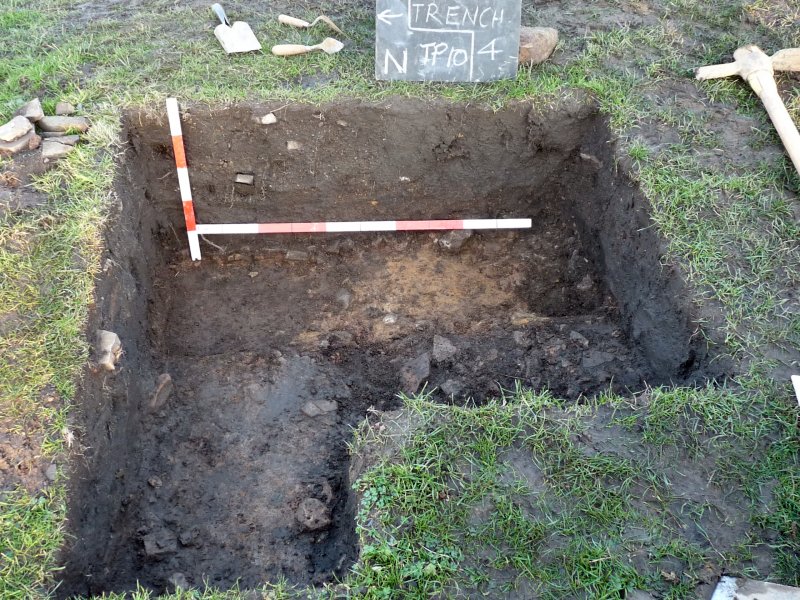
Date: 23rd October 2019
Respectable turnout this week even though it was just to do back filling (me, Andy, Chris, two Johns and Patrick). The plan however was to have one last go at the road section as I wasn’t convinced the north face of our section was giving a true picture of the road structure we had uncovered. Particularly telling was the gap here shown in the plan of the compact stony surface initially exposed. We therefore started by spending some time re-cleaning the stony surface to reestablish surface edge to gain an idea of its true profile. We also took down the fill beyond the edge to the level of the dark band which extends across from the lower stony surface.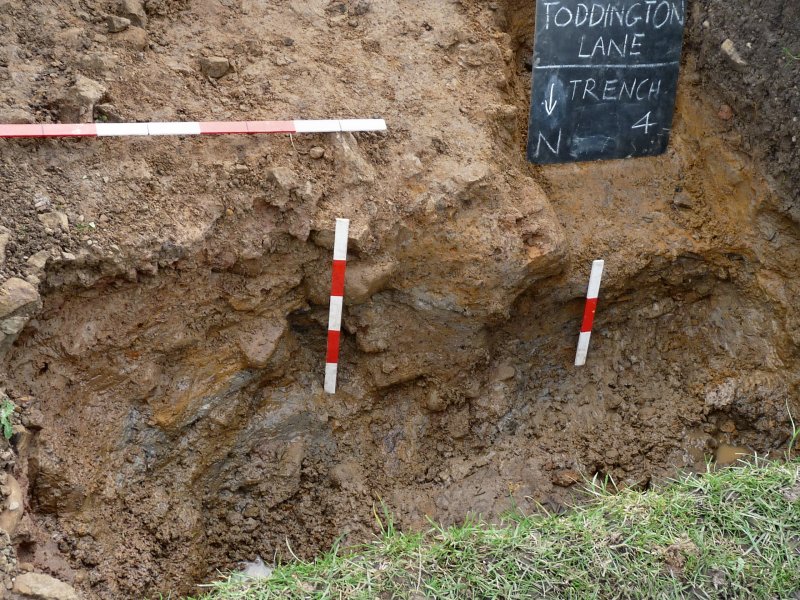 It seems from the section exposed that that this dark band, in actual fact, continues across the lower stony surface and is corresponding with the band of gray clay we uncovered lying just above the lower surface. This suggests an interval in road usage which allowed a build up sediment before the later road was built on top. Assuming the later road is late 18th century, this puts the earlier road much earlier. However the natural ground seems to be rising away from the road which suggests a hollow way which would indicate Medieval rather than Roman.
It seems from the section exposed that that this dark band, in actual fact, continues across the lower stony surface and is corresponding with the band of gray clay we uncovered lying just above the lower surface. This suggests an interval in road usage which allowed a build up sediment before the later road was built on top. Assuming the later road is late 18th century, this puts the earlier road much earlier. However the natural ground seems to be rising away from the road which suggests a hollow way which would indicate Medieval rather than Roman.
Meanwhile Chris and Andy were keen to investigate the post which had packing stones around it before it was back filled. This showed the remnant of the post to be about a metre long with a notch in it proving that it had come from an earlier other structure.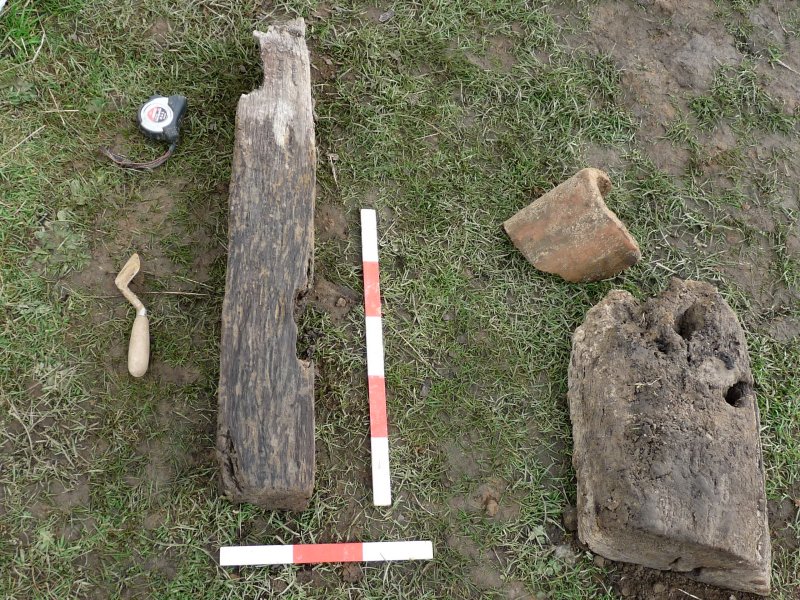 At the bottom of the hole a hard surface could be seen and a quick check with the dumpy level proved that it was at the same level as the other lower hard surface in the road section.
At the bottom of the hole a hard surface could be seen and a quick check with the dumpy level proved that it was at the same level as the other lower hard surface in the road section.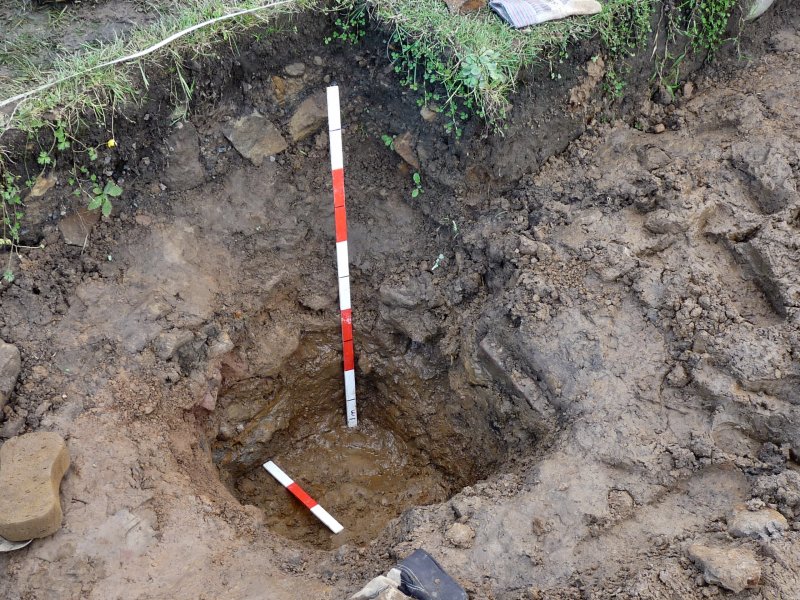
One last throw of the dice saw us investigating a small mound just to the north of our trench (it’s on about 2m across and perhaps 30cm high but this feature has fascinated Patrick all season).
It is early days but there seems no apparent reason for the mound. Our, quarter section test pit, revealed just a level scattering of small stone lying below the build up of plough soil – but this does not seemed to have any connection with the road we have been excavating (too high and too far to the west).
Date: 15th October 2019
Not many digging days left in the season so need to wrap this site up before the cold weather sets in – similar team as last time, but with addition of Neil Tattersall from Horwich (Patrick again joined later to pass judgement).
First job was to pump out the swimming pool that had developed in the road section (pump was working well but with so much water, ended up overheating with the effort).
 While that was being done it was agreed we had more or less gained everything we could from the well site itself and so decided to back fill it.
While that was being done it was agreed we had more or less gained everything we could from the well site itself and so decided to back fill it.
Before starting however the last of the lower flags was lifted to see if there was any culvert structure underneath (which seemed logical as it was the shortest route from the well to the field drain). No such route could be found and just to confound the mystery a piece of Victorian blue and white pottery was discovered amongst the flat stones beneath it, proving that the whole structure was as old as we were thinking (or certainly had been reconfigured at some point after the mid 19th century). During the back filling we were careful to maintain the flow of water from the culvert feeding the well, through the well and into the field drain (the well itself was packed with stones so a not to leave a cavity).
Once the road section had been pumped dry (well a dry as we could) we began the arduous task of hacking through the lower stony surface we had come across last time. his proved particularly difficult as it was comprised of large stony blocks.  These were reddish in colour with some having what looked like a black coating. However when a block was broken it was revealed to be a light purplie grey in side (the coating was probably due to leaching of some chemical or other in the clay). We finally got through the hard stony layer and below it we came across a light grey gritty clay which had rounded pebbles dispersed in it. Could this be the natural? it certainly was different than the soft clay we had detected on the west side of the trench. Pieces of cannel coal coming out of the layer however, suggest that it probably wasn’t. We’d gone as far down as we could go as water constantly flowing into the bottom of the trench so no further investigation was possible.With Ken’s help I managed to the section draw but this doesn’t tell the full story – as we cut back the east face, we were surprised to see so many layers of differing colours in just a short space – it was just like a layer cake.
These were reddish in colour with some having what looked like a black coating. However when a block was broken it was revealed to be a light purplie grey in side (the coating was probably due to leaching of some chemical or other in the clay). We finally got through the hard stony layer and below it we came across a light grey gritty clay which had rounded pebbles dispersed in it. Could this be the natural? it certainly was different than the soft clay we had detected on the west side of the trench. Pieces of cannel coal coming out of the layer however, suggest that it probably wasn’t. We’d gone as far down as we could go as water constantly flowing into the bottom of the trench so no further investigation was possible.With Ken’s help I managed to the section draw but this doesn’t tell the full story – as we cut back the east face, we were surprised to see so many layers of differing colours in just a short space – it was just like a layer cake.  These colours represented different material – from the top down we had pale yellow sandstone, then red sandstone, then yellow compacted gritty clay, then a band of grey clay, the more compacted gritty clay. Under that were the large sandstone blocks with the reddish coating and finally below that the grey gritty clay with pebbles in it. It was certainly a well built structure with seemingly many rebuilds – but with no finds, its age eludes us. However, from the band of grey clay we did get pieces of wood which could be dated if we had enough money for C14 dating but as it was from the bottom, it would still not tell us the age of its original construction.
These colours represented different material – from the top down we had pale yellow sandstone, then red sandstone, then yellow compacted gritty clay, then a band of grey clay, the more compacted gritty clay. Under that were the large sandstone blocks with the reddish coating and finally below that the grey gritty clay with pebbles in it. It was certainly a well built structure with seemingly many rebuilds – but with no finds, its age eludes us. However, from the band of grey clay we did get pieces of wood which could be dated if we had enough money for C14 dating but as it was from the bottom, it would still not tell us the age of its original construction.
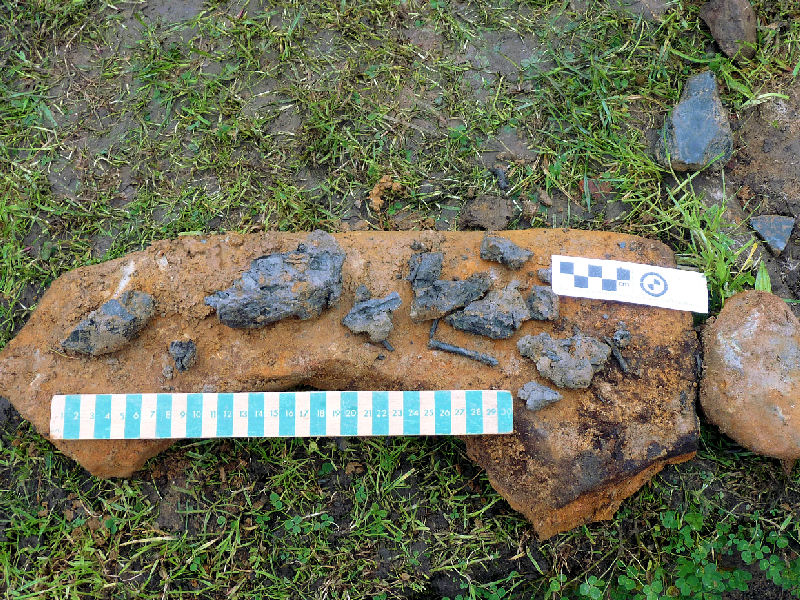
Pieces of wood from the grey clay layer (sitting on one of the large stone blocks with the reddish outer surface and sometimes black coating).
Date: 11th September 2019
Slightly depleted crew today – just me, Andy, John Smalley, John Needle from Atherton and Ken Scally (Patrick turned up at the end of the day having not read the email properly). Anyway jobs to do – try to finish the section through the road to establish its structure and also look at area between the well and the track to see if the road reappears there. So first thing was to remove the remnant of the upper flag floor and trowel down to the the next level. This revealed more on the lower flag floor but it also showed that the lower floor did not extend beyond the first to flags. Meanwhile Andy, having discovered wood in another post hole, resolved to remove it (a very small post hole was also discovered close by with the sharpened end of a small post still in situ – which he also removed). When the larger post base came out it was shown to be a half log with a square sawn-off end.
Meanwhile Andy, having discovered wood in another post hole, resolved to remove it (a very small post hole was also discovered close by with the sharpened end of a small post still in situ – which he also removed). When the larger post base came out it was shown to be a half log with a square sawn-off end. The arrangement of these posts are intriguing and, if contemporary, with no obvious function – too far away to be a canopy of the well and too close together to be a gated entrance or fencing.
The arrangement of these posts are intriguing and, if contemporary, with no obvious function – too far away to be a canopy of the well and too close together to be a gated entrance or fencing.
Work on the road section was proving difficult with a constant stream of water percolating through the side walls and the compacted stone being hard to cut through. It became obvious though, that a second surface existed at a lower level – could this be the same lower surface we had discovered in our previous excavation further up the hill in 2017? It was strange though, that the body of this lower surface was below the dark band in the section to the side of the road which we are assuming to be interface with the natural underlying clay.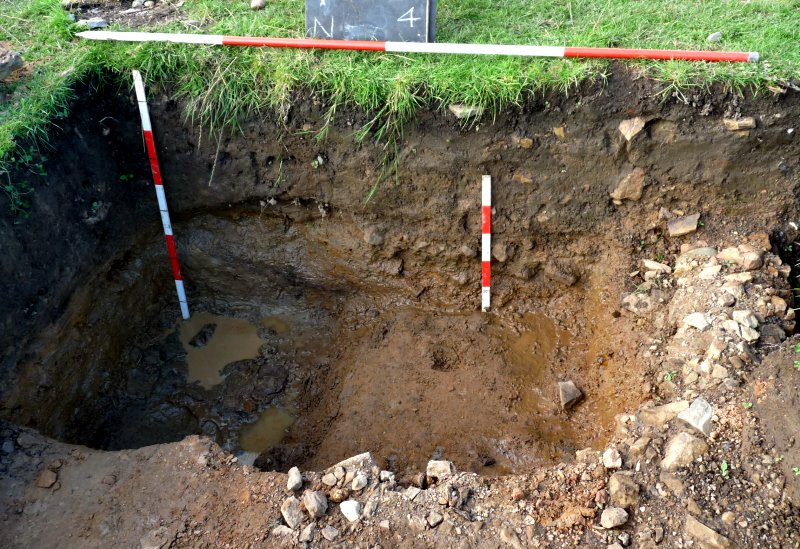 On closer inspection though, it can be seen that the dark band does dive downwards as it gets near to this lower surface.
On closer inspection though, it can be seen that the dark band does dive downwards as it gets near to this lower surface.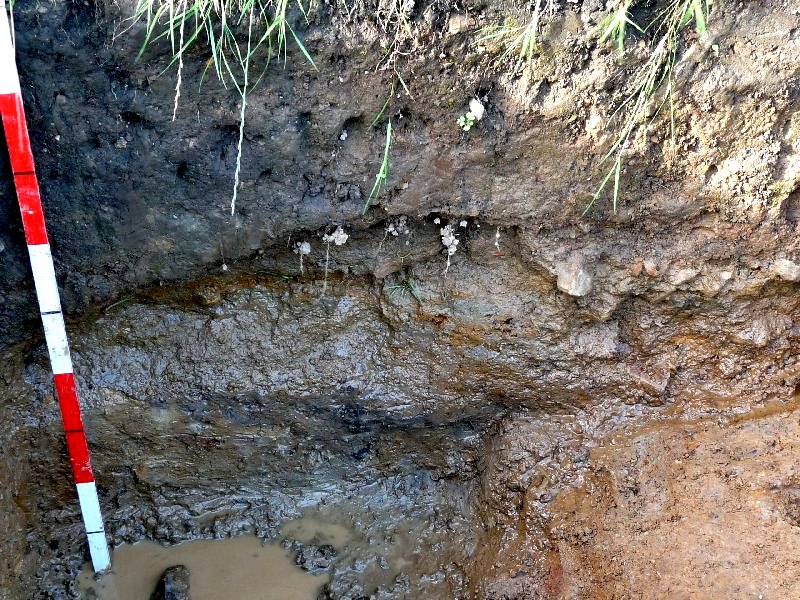 If we accept that the clay on the left is the natural, our only interpretation must be that this a hollow way (relaid a couple of times) and therefore medieval rather than Roman (if only we had a find or two to prove it).
If we accept that the clay on the left is the natural, our only interpretation must be that this a hollow way (relaid a couple of times) and therefore medieval rather than Roman (if only we had a find or two to prove it).
Date: 19th August 2019
Similar turn out to last time and much more rain, the result being the well had started to work again i.e. water was now flowing through the culvert and filling the well.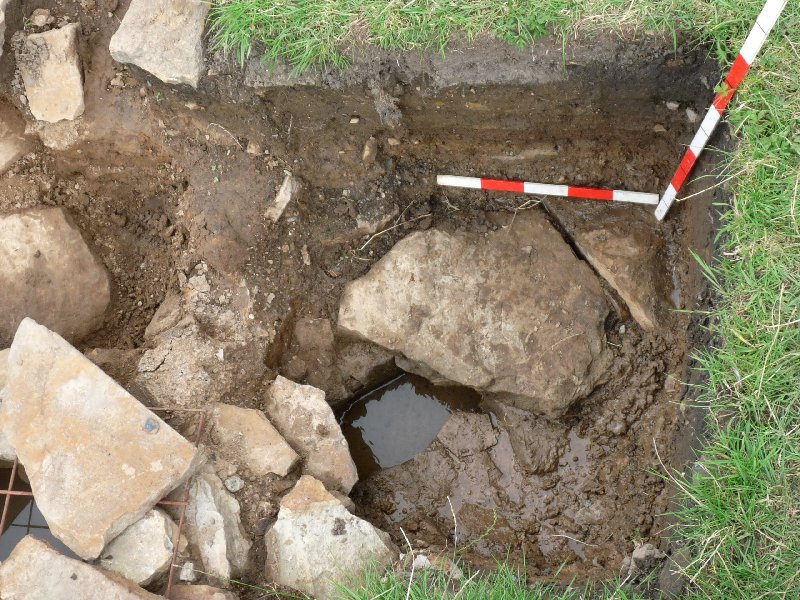 The well being now full, was overflowing through the hole under the lintel on the north side. It wasn’t clear whether this hole was the originally intended exit or not but if not the water in the well would have risen too high for the water entering fro the culvert. However, after removing more stone work from in front of the well, there didn’t appear to be any evidence of a channel running from the hole to the field drain.
The well being now full, was overflowing through the hole under the lintel on the north side. It wasn’t clear whether this hole was the originally intended exit or not but if not the water in the well would have risen too high for the water entering fro the culvert. However, after removing more stone work from in front of the well, there didn’t appear to be any evidence of a channel running from the hole to the field drain. Meanwhile the wall of the trench we had cut through the compacted stony area had suffered badly from the standing water since our last visit. It took some while for us to clean it up.
Meanwhile the wall of the trench we had cut through the compacted stony area had suffered badly from the standing water since our last visit. It took some while for us to clean it up. 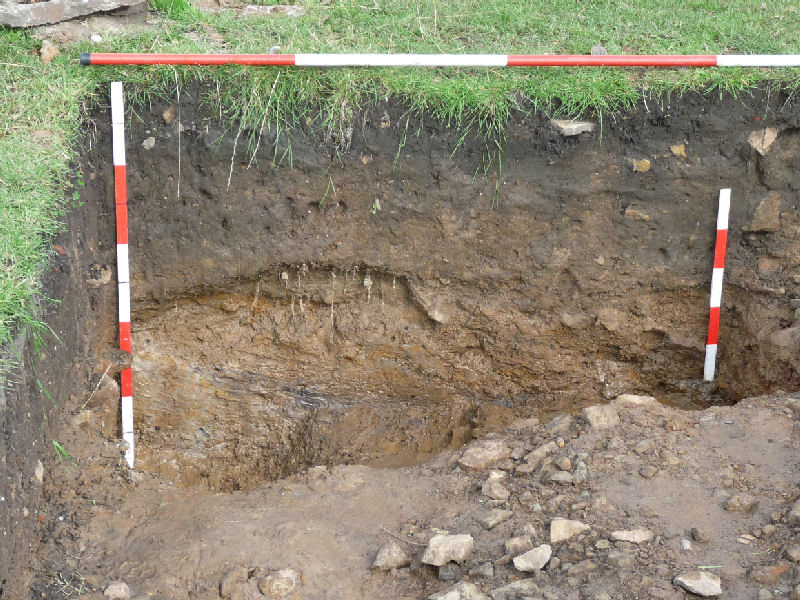 The revealed section, however, seems to be indicating that our road was in fact a hollow way. Streaks of dark organic matter indicated the change from clay fill to natural clay.
The revealed section, however, seems to be indicating that our road was in fact a hollow way. Streaks of dark organic matter indicated the change from clay fill to natural clay.  On the one hand this is disappointing as we’re look for evidence of a Roman activity but on the other hand it puts its construction back to the medieval period.
On the one hand this is disappointing as we’re look for evidence of a Roman activity but on the other hand it puts its construction back to the medieval period.
Date: 24th July 2019
Back on site after a spell at the Burscough site but still a good turn out – with me and Andy were John Smalley, Chris Drabble, John Needle and Ken Scally, with Patrick and Mark Tildesley joining us later. First job was to remove the upper layer of flags starting with the ones furthest away from the well (these flags having been fully recorded last time including a section drawing). A bit of rain since our last visit making our work more difficult but at least its given the exposed stones a good cleaning.
Once the flags and the underlying large stones had been removed from this initial section, the full profile of the recently discovered post hole could be revealed. With the lower part of the wood still in situ, only the front section of the post hole could be excavated but this was enough to reveal it depth – about 25cm – but to our surprise at another 3 or 4 post holes tuned up (although at least one of these had evidence of being a rotted tree root), although particular pattern could be detected.
We also remove some of the packing stones from the first post hole discovered and a similar section excavated. This time the depth of the post was 50cm below the packing stones.
We made an attempt at cutting a section through the compacted stonework at the north end of the trench but this proved to be very difficult. However towards the edge of it we managed to reach what could be the original surface. The gritty sandy clay what discoloured with black and dark brown streaks and lenses embedded in it. Yet to be confirmed but this layer seemed to be running under the compacted stonework.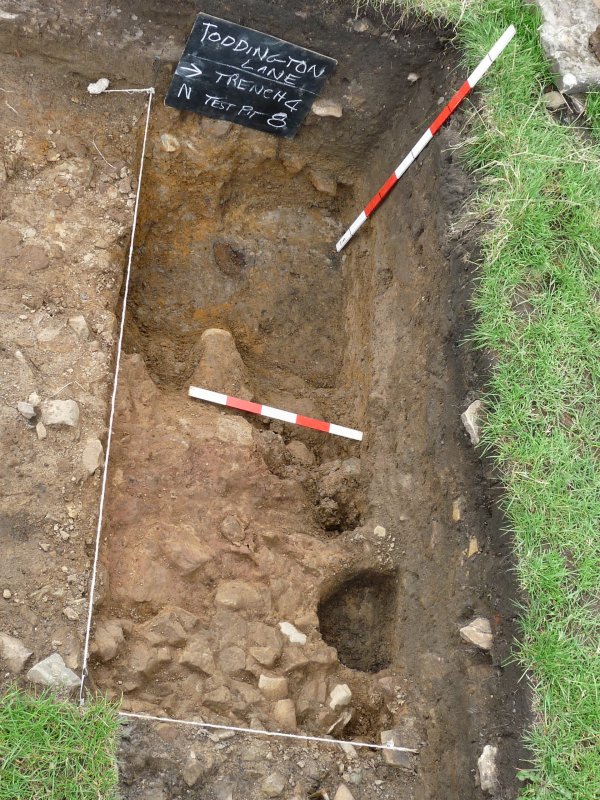
Date: 8th July 2019
Six of us on site today – Andy and I were joined by Chris Drabble, John Smalley, John Needle (who caught the train from Atherton and walked it from Hindley Station – there’s dedication for you) and later Neil Tattersall from Horwich. Chris brought his drone and before we began work he did a scan of the site (apparently by using software on the ‘Maps Made Easy’ website the images can be stitched together to create an accurate plan (invaluable for my drawing). Other effects can also be achieved, the best one for us being the creation of a 3D model (similar to Lee McStein’s work a couple of year’s ago on Mrs P’s milestone). You can view the model Chris has made here (just have to be patient for it to load though).
Other effects can also be achieved, the best one for us being the creation of a 3D model (similar to Lee McStein’s work a couple of year’s ago on Mrs P’s milestone). You can view the model Chris has made here (just have to be patient for it to load though).
Once Chris had finished his scans he got to work with John N, taking down the fill on the edge of the compacted stonework, to see if it continued going down. If we could find the edge we could then open up a section. In the meantime John S and I set up to draw a section across the flagging leading up to the well. John N’s work last time removing the brickwork above the field drains had indicated a second layer of flagging below it so we needed to record the first layer before we removed it.
After we finished the drawing, John S and I set to work removing the brickwork and field drains. This proved our previous assumption correct that there was a second level below the first, constructed of a huge stone slab. Removing some of the stone flagging revealed the levels however were separated by a rough layer of soil, stone and brick, suggesting the second level was a rapid, fairly haphazard construction. Cavities below the large stone flag suggest water overflowing from the well found its way through these to be carried away by the field drains.
While we were doing this, Andy was determined to investigate the the hole discovered in the well on its south east side (to see if our theory was correct that it was the feed for the well). To do this he had to take back a section of the trench in that area so that he had room to work his way down the side of the well without disturbing its construction. With help from Neil, he eventually reached what he was looking for, large stone slabs which looked typical of a stone built culvert of this period.
And sure enough, when some of the stones were removed the culvert was revealed, stone lined with a stone floor. However it still leaves the question where was the culvert leading to – was there a spring in the area, or was it just part of the field drainage system?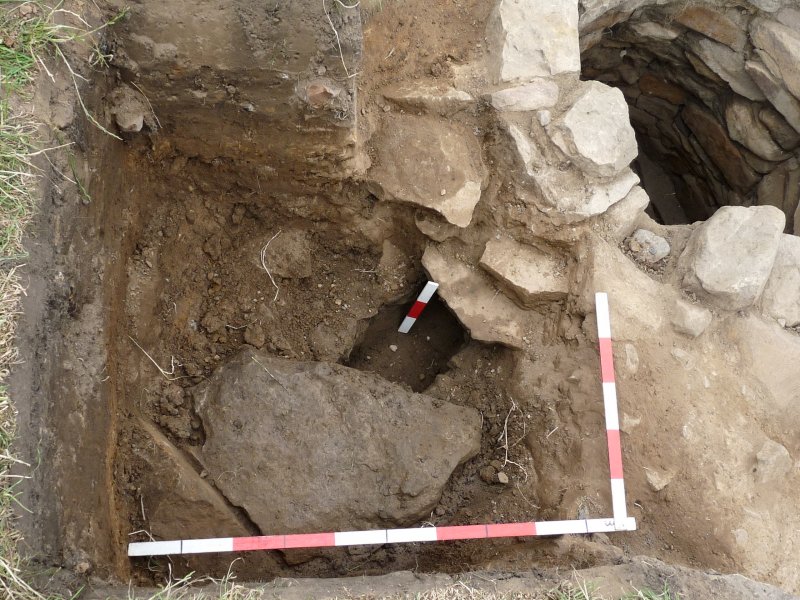
Meanwhile work continued on the compacted stonework and eventually the edge of it seemed to emerge, although this was far from clear. However it now gives us an idea of the size of the section we need to put it to investigate its depth.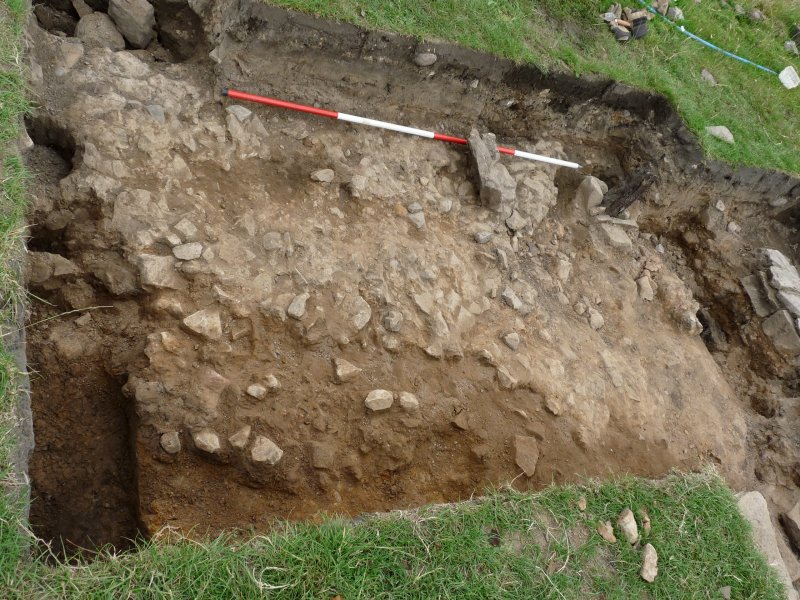
Date: 2nd July 2019
Another great turn out – with me, Andy and John Ashton we had Chris Drabble, John Smalley, John Needle (too many Johns on one site), Sam McLoughlin and Patrick, – and later Ken Scally (joining us for the first time). Again logistics proved difficult on such a small site with a system of ‘turns’ having to be adopted.
First task was to explore the extent of compacted stonework. To do this, it was decided to join our two trenches up – this was a biggish task but after all we did have the manpower. Meanwhile Sam was tasked with bailing out the foot of water collected in the bottom of the well and cleaning it up, while John N and Ken were given the job of exposing more of the field drains and the area leading up to them.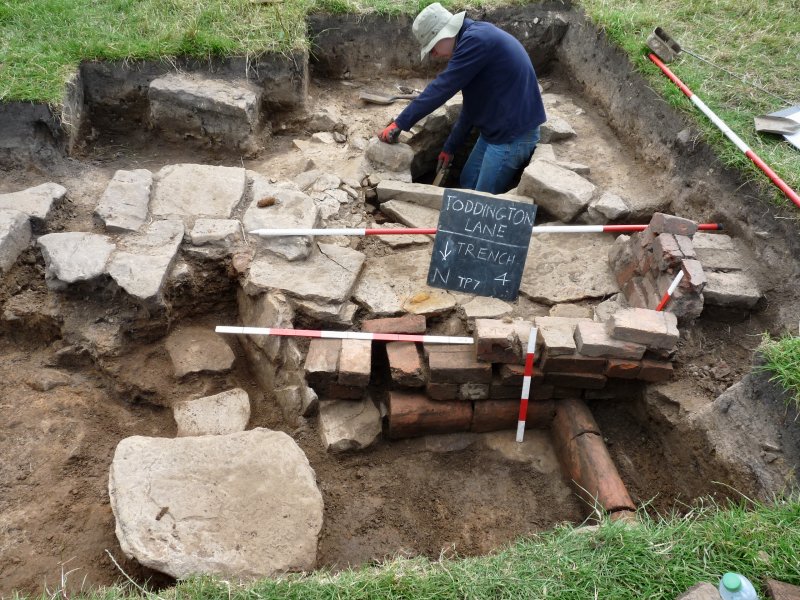
This revealed that the second drain did not go anywhere, just ending with a blocking stone and beyond that a large flat stone on its edge seeming to define the edge of the well area on that side. The upturned ‘U’ shape style of the field drains date them to the early part of the 19th century (exactly the same as the ones we had come across at our Brimelow Farm excavations last year).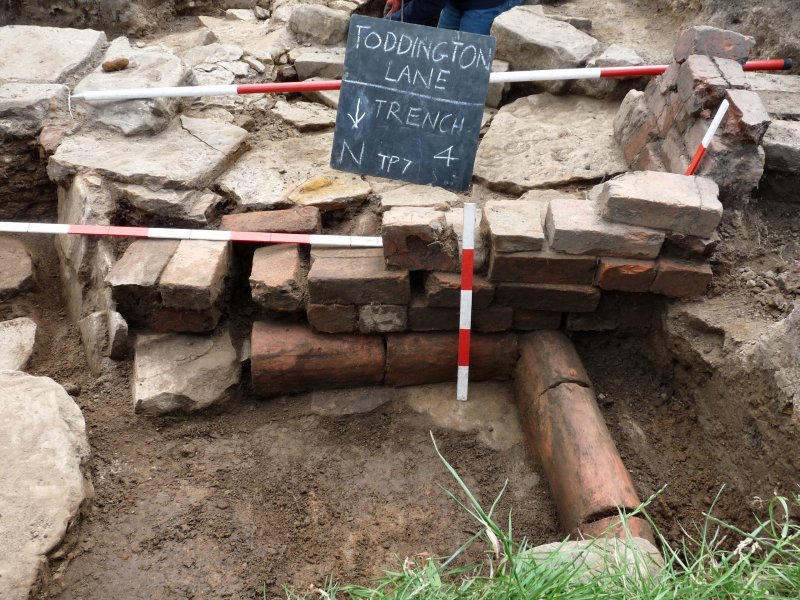
Meanwhile after some effort the two trenches were eventual joined up and a large area of compacted stonework was revealed. It seemed to have a edge to it but the fill beyond had flecks of charcoal and Buckley ware in it so not natural (we would need to section this at some point to get the true picture).
Particularly strange was large flat stone protruding from the stonework at a 45 degree angle. The arrangement of the stones around it and its closeness to the post with the packing stones (less than a metre away) suggest it could be part of a gate jamb.
And yet another post hole was discovered – this time slightly under the flagged entrance.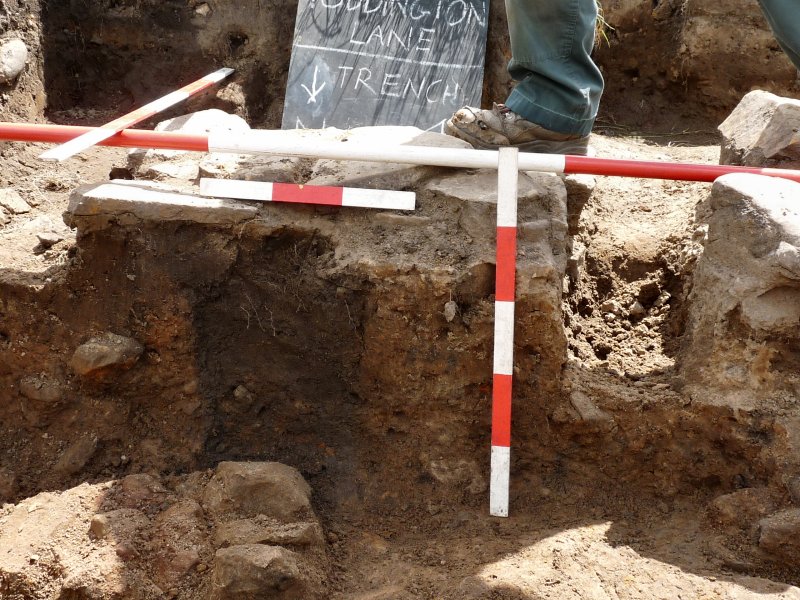
Andy, demonstrated his skills at half-sectioning, revealing a good portion of the wooden post still in situ but no packing stones. We now have 3 posts/post holes but there doesn’t seem to be any connection at the moment.
We now have 3 posts/post holes but there doesn’t seem to be any connection at the moment.
Date: 23rd June 2019
Second day of our GM Festival of Archaeology and another good turnout. Four members of the general public joined us today, including Samuel McLoughlin, Dawn Needle and husband John and Neil Tattersall. Adding to this were five members of our group (with me and Andy were Patrick, Mark Tildesley and for the first time on site Mark Chivers).
To develop our new trench (Test Pit 8), Neil was tasked with extending John Ashton’s sondage and cleaning the stony surface leading up to it. At the other end of the trench (east side next to the fence), Patrick began to explore the area where the various layers had suggested the road had been relayed at various times. This turned out however not to be the case. Loose material continued to be removed to a depth of about 0.5m and, when he eventually reached the bottom, the true reason was revealed. A large diameter plastic pipe emerged, revealing in fact the mains water supply leading up the lane.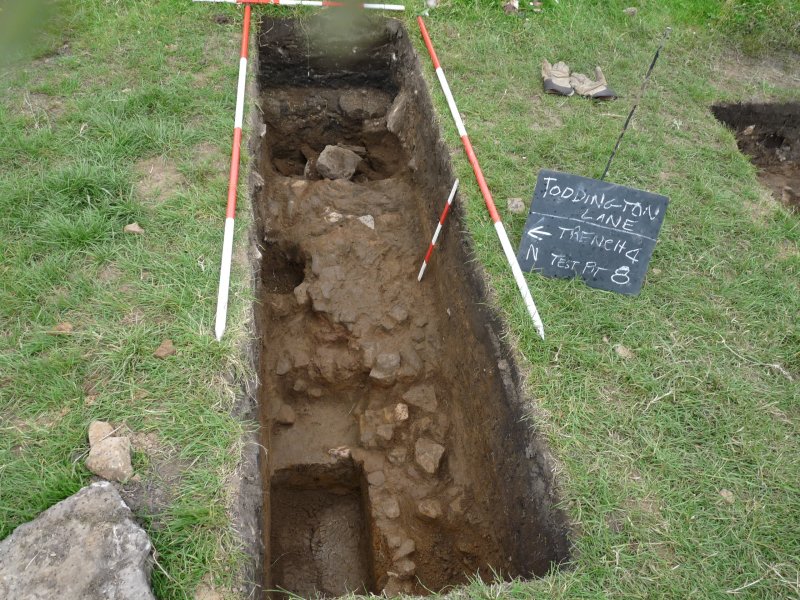 In the meantime Neil was making a great job at the other end of the trench (west side) revealing more of the compacted stonework. This showed that it had some depth to it and extended to the sondage and beyond (it was strange though that where John had dug there appeared to be no stones).
In the meantime Neil was making a great job at the other end of the trench (west side) revealing more of the compacted stonework. This showed that it had some depth to it and extended to the sondage and beyond (it was strange though that where John had dug there appeared to be no stones).
In our original trench (Test Pit 7) Mark C and John N were tasked with extending eastwards towards the fence to see if the stone flagging emanating from the well itself, continued towards the lane. This proved to be the case but far less substantial and had a confusing gap in between. Also, as before, the flags seemed to be placed on nothing more substantial than loose earth.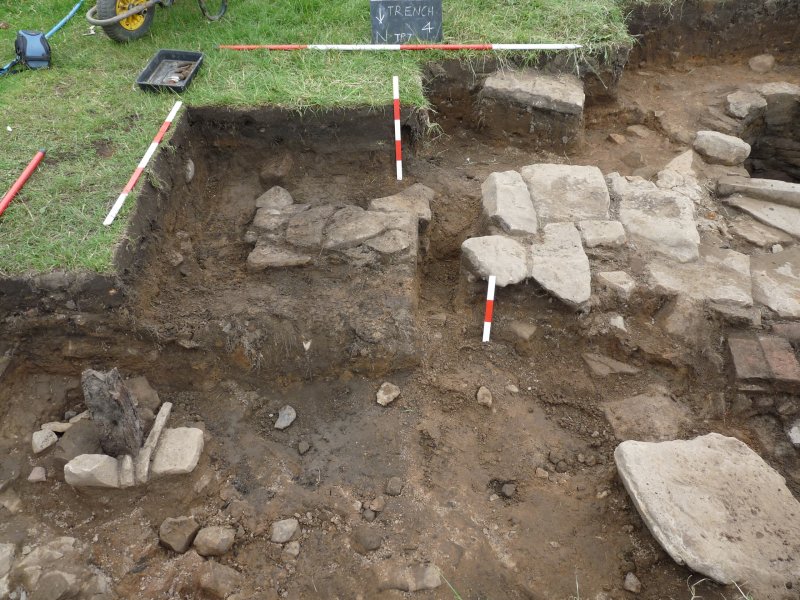
Meanwhile Dawn busied herself cleaning up the area around the field drain in the northwest corner of the trench. Later helped by her husband John, she was able to remove the loose brickwork revealing more of the underlying brickwork. This revealed, strangely enough, another field drain teeing off at right-angles to the first running under the brickwork.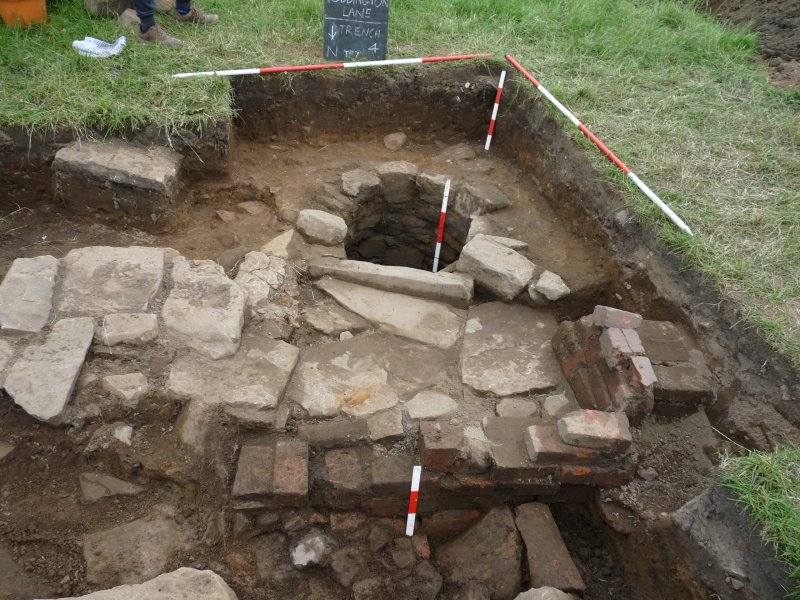 In the meantime Andy and Sam were tasked with extending the trench 0.5m southwards to expose the full extent of the well and, therefore, its construction to be examined. Previously Mark T had washed down the inside walling of the well revealing the quality of its construction. It also revealed a hole on the south east side – could this be the feed for the well (the well doesn’t seem deep enough to have reached the water table so the water must have got in another way).
In the meantime Andy and Sam were tasked with extending the trench 0.5m southwards to expose the full extent of the well and, therefore, its construction to be examined. Previously Mark T had washed down the inside walling of the well revealing the quality of its construction. It also revealed a hole on the south east side – could this be the feed for the well (the well doesn’t seem deep enough to have reached the water table so the water must have got in another way).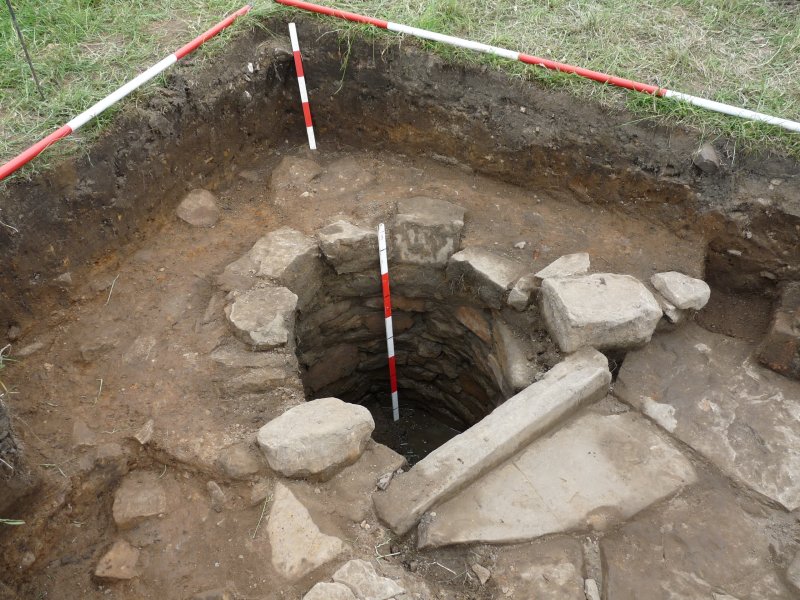
During the two days of the Festival we had a constant stream of visitors interested in our activities. This gave Patrick and I plenty of opportunity to explain the reasoning behind our assumption that the Toddington Lane was the original Roman route between Wigan and Ribchester and why we had thought there was a well here (on the last day we even had the privilege of meeting Patrick’s mum and misses whose visit was a great demonstration of the wide ranging interest in our discoveries).
Date: 22nd June 2019
Good turn out on our first day of this year’s GM Festival of Archaeology. Five place had been booked on Eventbrite but only four had responded and one of those had cancelled. The remaining three who turn up on the day, Karen Dolan, Fran Haygarth and Heather Cook, had a great time helping us to excavate our site. Joining these from our members, beside myself, were Andy, John Ashton (on this site for first time), Patrick, Chris Drabble and his partner Denise, John Smalley and later Mark Tildesley. 
Eleven operatives on site was a logistical challenge, trying to get everybody working on such small site without interference from each other.
Heather and Fran were tasked with troweling the area around the wooden gatepost. Karen was asked to look at the area just behind them where the seeming flag floor ended. Chris was given the task of removing the pile of sandy clay and stones surrounded by the brickwork (this had obviously been just dump there). Meanwhile Denise was asked to clean the area around the culvert. The rest of us concentrated on removing the south west corner of the trench and expanding the it 0.5m southwards. This was to expose more of the well we had discovered the previous week.
The fist discovery of the day was made by John A in Test Pit 8. Taking the trench down to the level reached in Test Pit 7 proved difficult as large stone blocks, seemingly randomly placed, hampered progress. Layers of different materials seemed to bare evidence of relaying of the road on the east side, albeit narrower than before. John also uncovered evidence of a post-hole which seemed to be on line with the wooden post in Test Pit 7.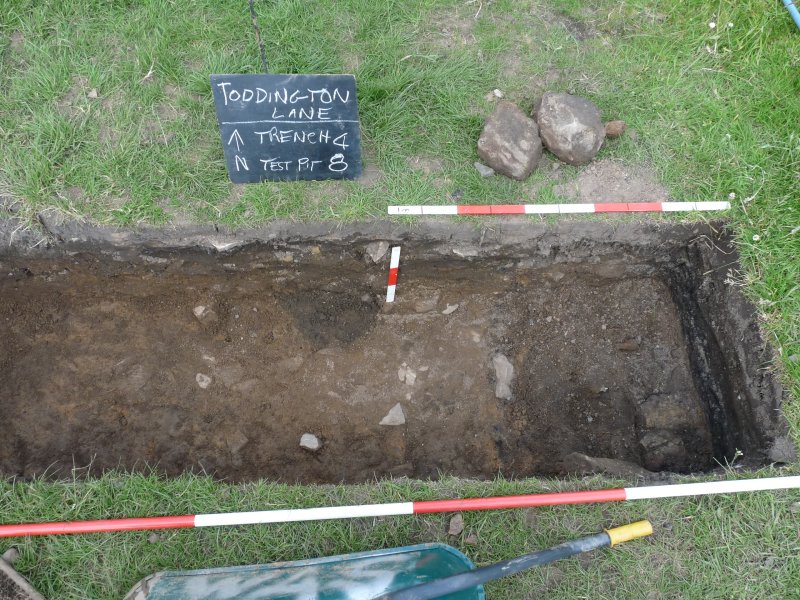
This post-hole had been punched through the hard surface (difficult to see in the photo) which continued almost all the way across the trench. Only the last 1m on the west side was clean. John was therefore asked to put a sondage in at this point to see if the natural could be detected.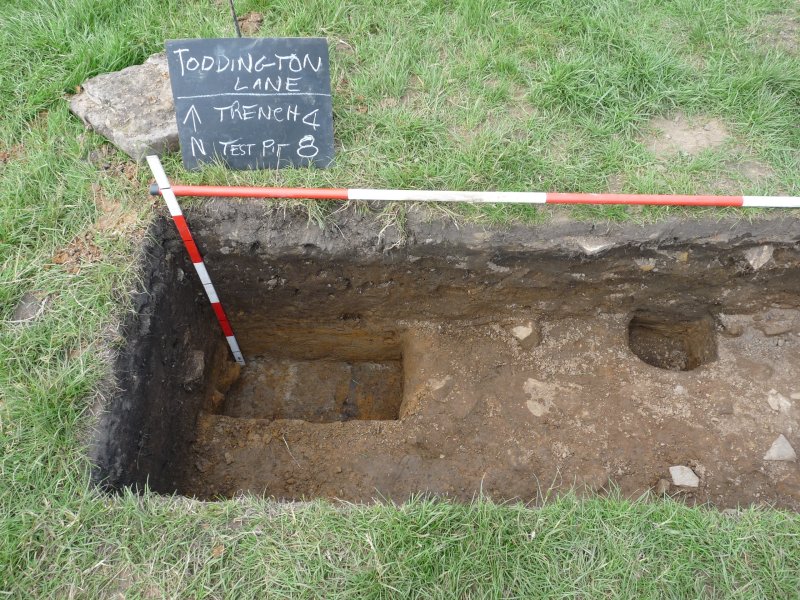
This seemed to appear straight away as a sandy clay material, suggesting that the found the limit of the stony surface.
Meanwhile Heather and Fran had been making a great job of cleaning the area around the wooden post. This revealed the large hole which had been punched through the stony surface enabling the post to be inserted. This confirmed that the post, however old it was, was in fact a later construction.
At the other end of the trench, Chris had identified a metal pipe under the rubble enclosed by the brickwork, which he left in situ while it was recorded. His partner, Denise, working in the north west corner, showed that the field drain there, was constructed of ‘u’ shaped tiles similar to the ones we had come across last year at Brimelow (the style date them to the early 19th century).
Meanwhile Andy and John S made great progress with the well revealing it’s full extend. After much effort Andy, with the help of Mark, eventually reached the bottom of the well which was about a metre below the surface.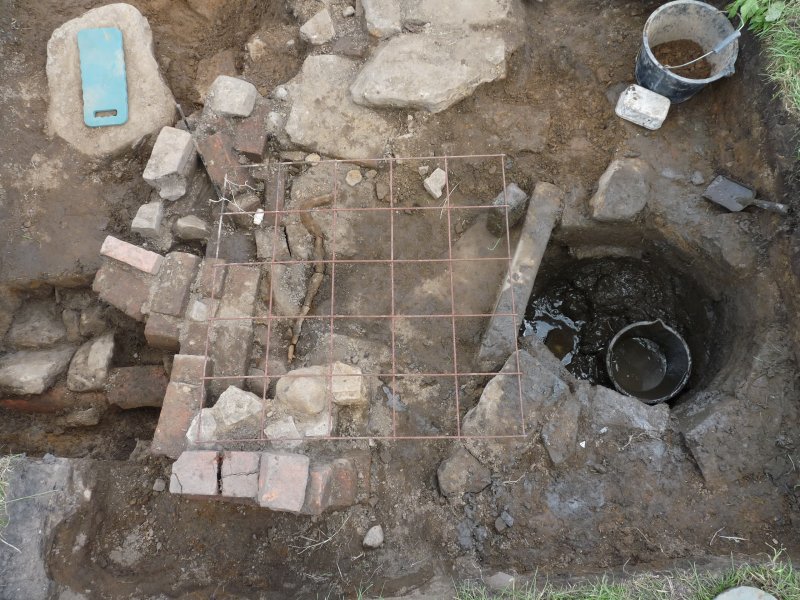
It appeared to be lined at the bottom with flags and had a distinct smell of something like diesel. Apart from a few sherds of Victorian pottery and bits of an iron bucket, no finds came out of it, the exception being a blackened branch-like object stuck to the flag base. Examining the inside wall of well under the lintel, small gap in the stonework gave the suggestion of an overflow perhaps leading to the field drain (we realised we would have to take up the flags in front of the well if we want to confirm this).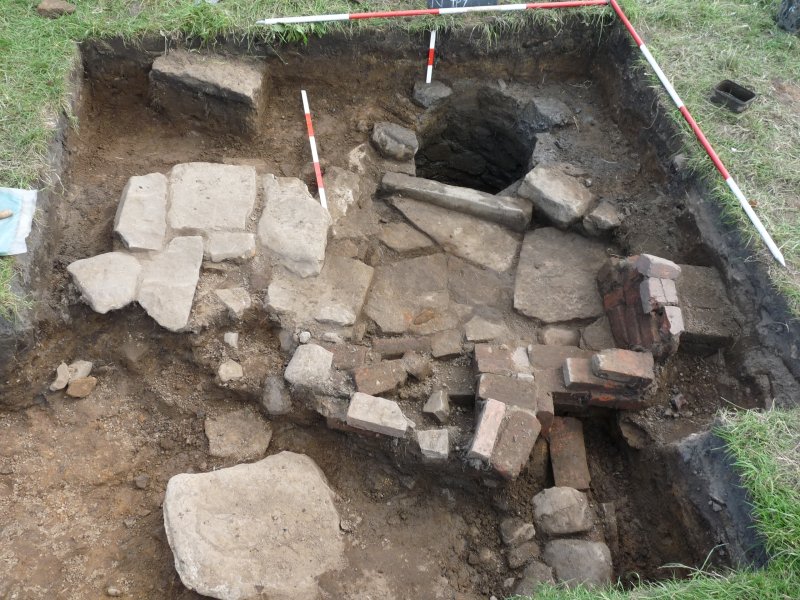
It turned out to be quite a successful day with a lot of archaeology exposed and it seemed that all are volunteers thoroughly enjoyed themselves.
Date: 18th June 2019
Five of us on site again today but with Andy replacing Dave North. It was obvious we needed to extend our southern extension once more both in a southerly and easterly direction. This revealed what appeared to be a flag floor leading down to the centre of our brick built feature. Cleaning up this centre we had, what appeared to be a pile of stone and sandy clay overlying substantial brickwork on the north and west side (none of it had been mortared together however). 
A section through the material enclosed by the brickwork, revealed bands of sand a clay suggesting barrow loads had seemingly been dump onto the feature. A small sondage at the base of the brickwork on the north side of the feature (bottom left in the photo below) revealed more stonework. It didn’t look connected to the large flat which we think has been randomly placed. Also reveal in the northwest corner of the trench (bottom right in the photo below) was what seemed to be a field drain running under the brickwork.
On the other side of this trench (in the south west corner), as we clearing the overburden , a large stone lintel began to emerge (although at a strange angle it did not look randomly placed). Keen to determine the depth of the lintel, Andy quickly excavated the fill on its south side, only for it to immediately fill up with water – had we found the actual well itself? On the north side of the lintel, a large flag butted up to it which seemed to be a continuation of the flag floor previously discovered.

This site is now turning into something much bigger than we initially anticipated and obviously we have a lot more work to do to finish it. However our other goal was to locate the old road on the this side of the track and with this in mind a new trench (Test Pit 8) was put in 1.5m south of this trench (2.5m x 0.75 offset by 0.5m further towards the fence). This would also give us more room for our volunteers at our two-day ‘Festival of Archaeology’ which is planned for the weekend.
Date: 17th June 2019
New member Chris Drabble joined myself, John and Patrick today with Dave North coming along later in the morning. First job was to extend our trench 0.5m eastwards towards the fence to see if we could uncover more of the stony surface we had detected last week. The area was peppered with loose stone making it difficult to identify a coherent stony surface but what did come as a surprise was the emergence of an intact wooden post still set in its packing stones. 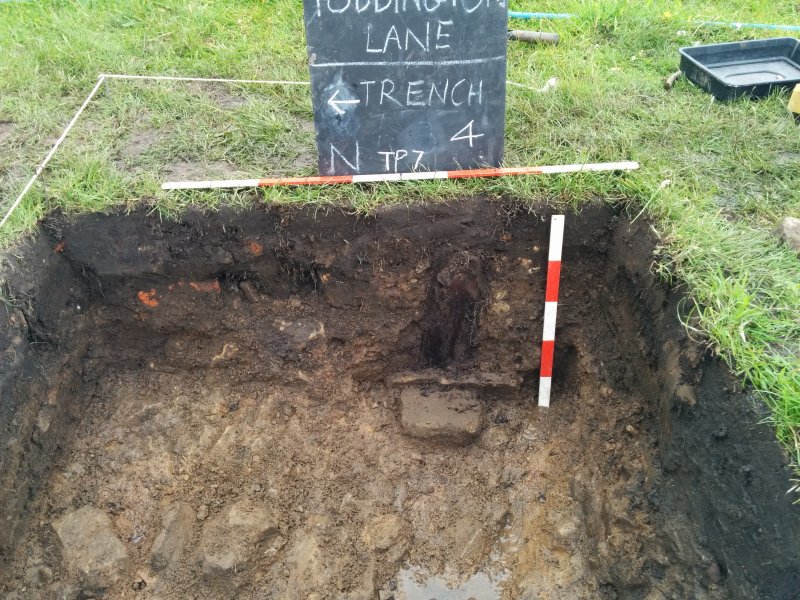
To expose more of the feature we extended the trench another 0.5m eastwards. A stony surface did begin to emerge and it was obvious that a hole had been cut into it to place the post with the packing stones.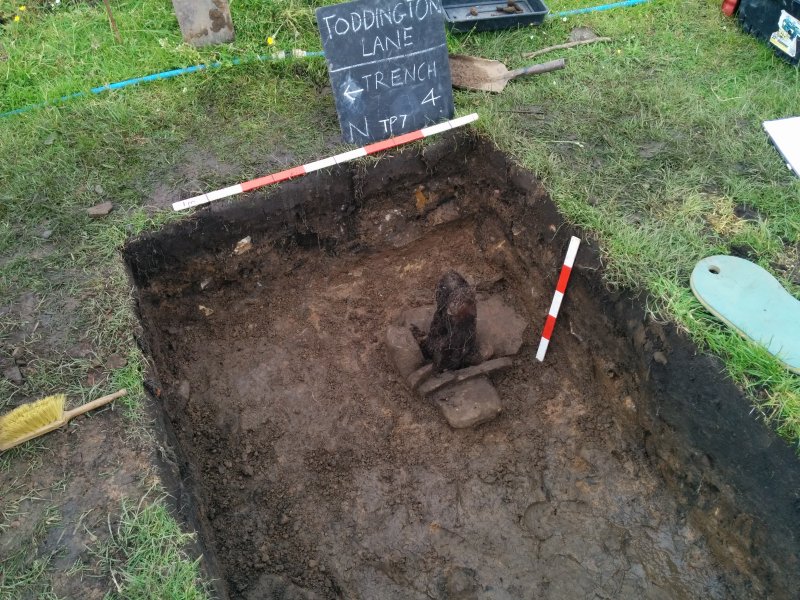
Remains of a large iron screw fell out of the north side of the post. If this was a gate post then this could have been the fitting for the hinge. With no hole on the opposite side of the post, it would suggest that, if this was a hinge fitting, the gate itself would have been on the north side.
Meanwhile we needed to investigate the brickwork which had begun to emerge on the other side of the trench. Stonework in this area also indicated that we needed to extend on the south side by 0.5m. The brickwork, although not mortared, seemed to have been orderly assembled rather than randomly dumped. A pile of bricks on the far west side of the tench seemed to be sat on a culvert constructed of a curved tile and a line of stones.
The brickwork, although not mortared, seemed to have been orderly assembled rather than randomly dumped. A pile of bricks on the far west side of the tench seemed to be sat on a culvert constructed of a curved tile and a line of stones.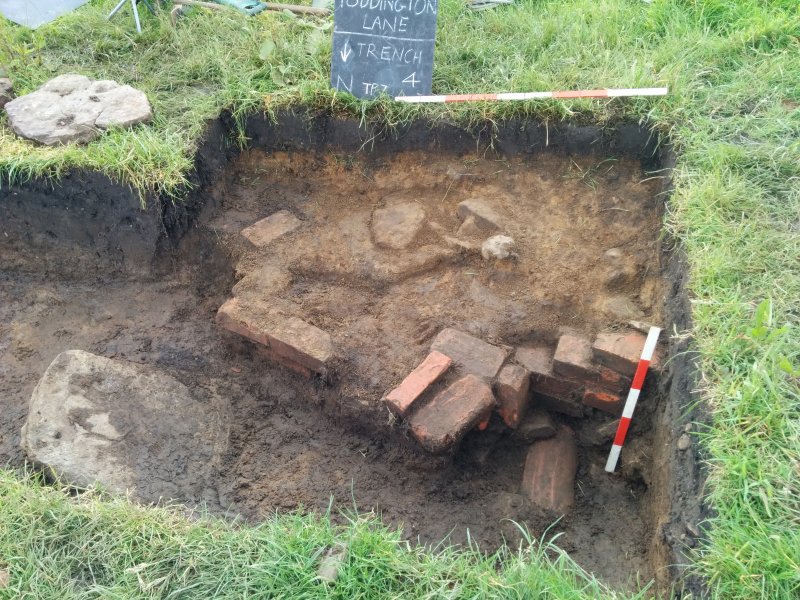
The brickwork continued westward beyond the edge of our trench. We therefore decided to extend our trench westward by 0.5m.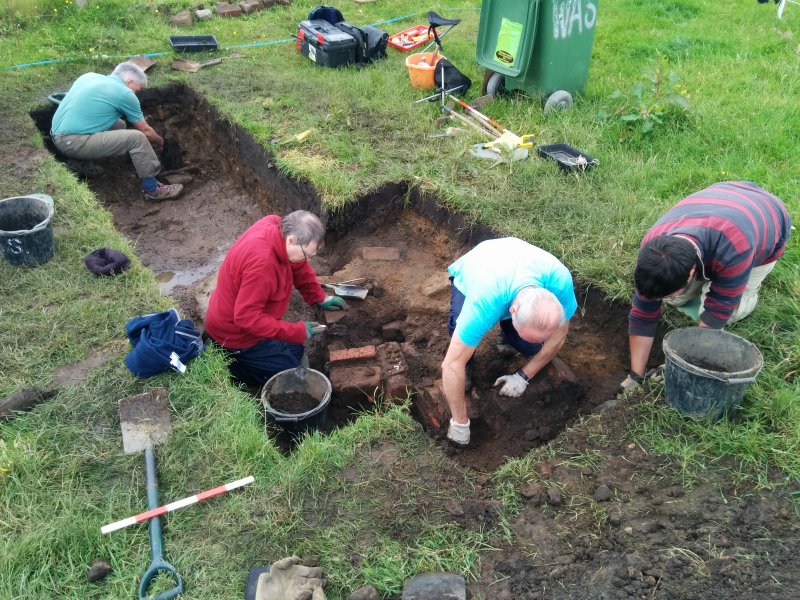
This revealed the extent of the brickwork on this side with a ‘pile’ of bricks running a to 90 degrees to the ones over the culvert.
Date: 10th June 2019
Today Andy and I were joined by John Smalley from Ormskirk (originally from Leigh though) and as usual by Patrick in the afternoon. First task was to bale out the site (seems we’ve hit the rainy season) and then widen the trench to 1.25m (on the south side) so that we could investigate the brickwork feature. Although two bricks were inline, the lack of mortar convinced us the bricks did not for a structure (Patrick assessed the bricks to be late 18th century due to their size and lack of ‘frogging’).
The soil fill between the stone and the east trench wall seemed to have a lot of stones in it. However at a depth of about 0.5m at stony surface was detected which did not extend beyond the the upright stone. With the stone and the brickwork appearing not to be a feature it was decided to remove them and take to whole trench down to the level of the stony surface.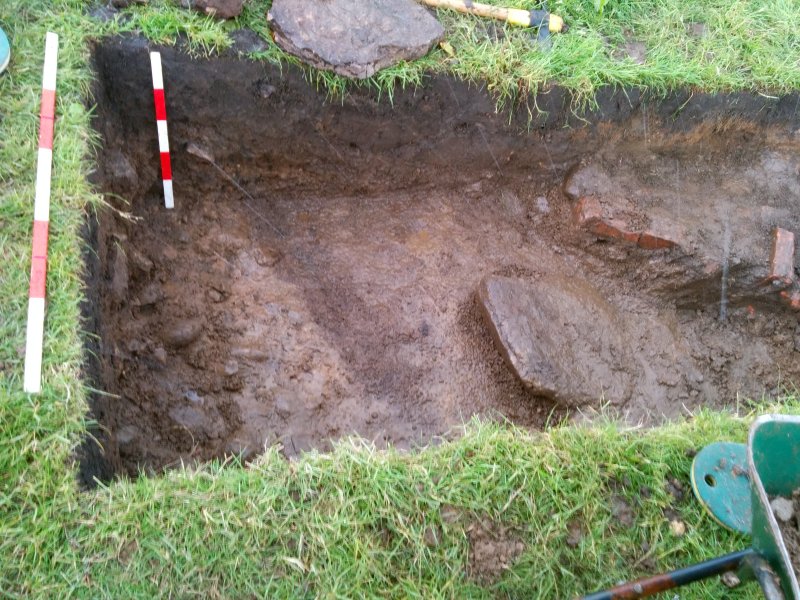 This revealed a dark shadow seemingly delineating the edge of the surface of stones (although running at a slight angle to it). Again more brickwork emerged on the west side of the trench but once again, although two bricks were inline, they did not appear to form a structure. Heavy rain quickly curtailed our activities for the day.
This revealed a dark shadow seemingly delineating the edge of the surface of stones (although running at a slight angle to it). Again more brickwork emerged on the west side of the trench but once again, although two bricks were inline, they did not appear to form a structure. Heavy rain quickly curtailed our activities for the day.
We had positioned our trench to hopefully discover the remains of the well (shown on the 1849 map) as well as the the old road – could be the bricks be the remnants of the well). The old map shows it well inside the thick line indicating the road but there is also a broken line – could this be the edge of the road and the thick line just the field boundary?
Date: 3rd June 2019
Andy and I on site early to be joined later by Patrick. We marked out Trench 4 (Test Pit 7 if it’s not the main trench) – i.e. 3 x 0.75 metre at 21 metres from the bottom fence line and 2 metres from the track fence line (the long side perpendicular to the fence line). 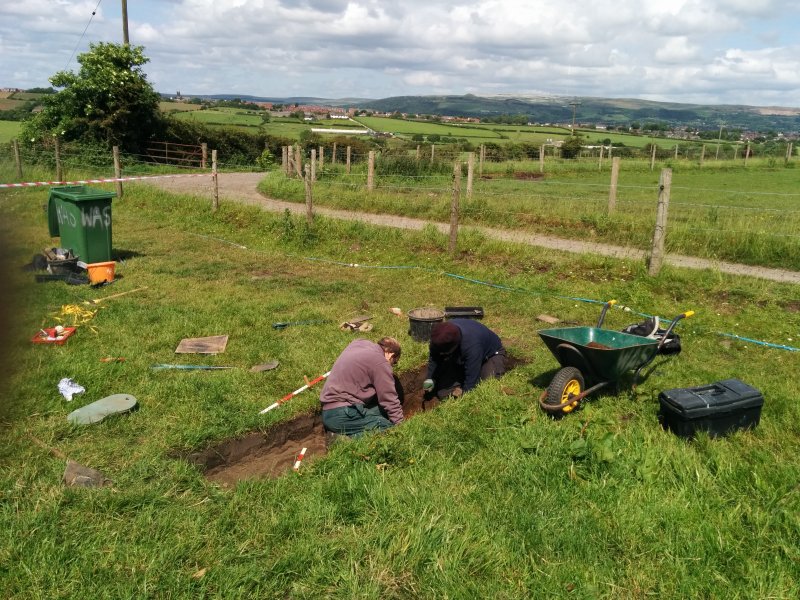
We soon reached the sub-soil – a clean sandy brown layer with nothing in it except one large flat-ish stone seeming standing upright (oh no not another milestone!).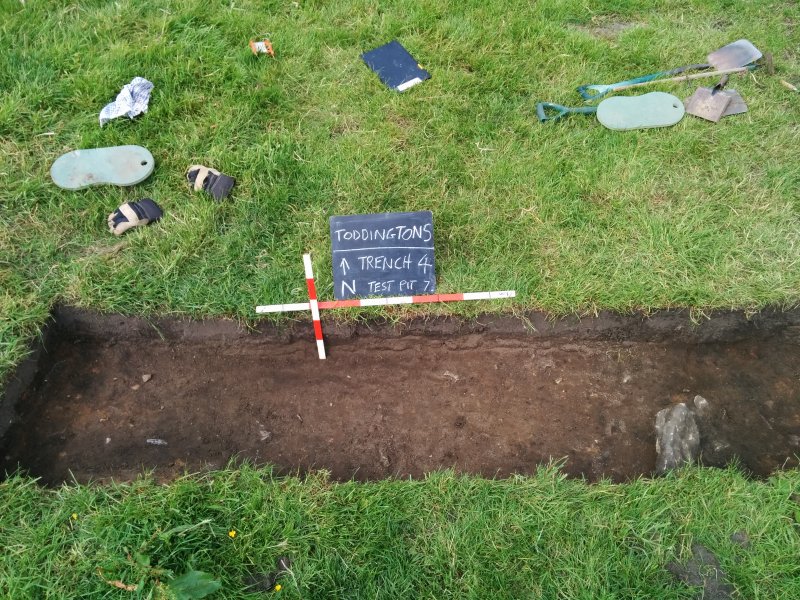
Explore the area around our ‘standing stone’ (which was leaning over slightly) we discovered it seemed associated with some brickwork and a second stone, this time lying flat, just 0.5m away.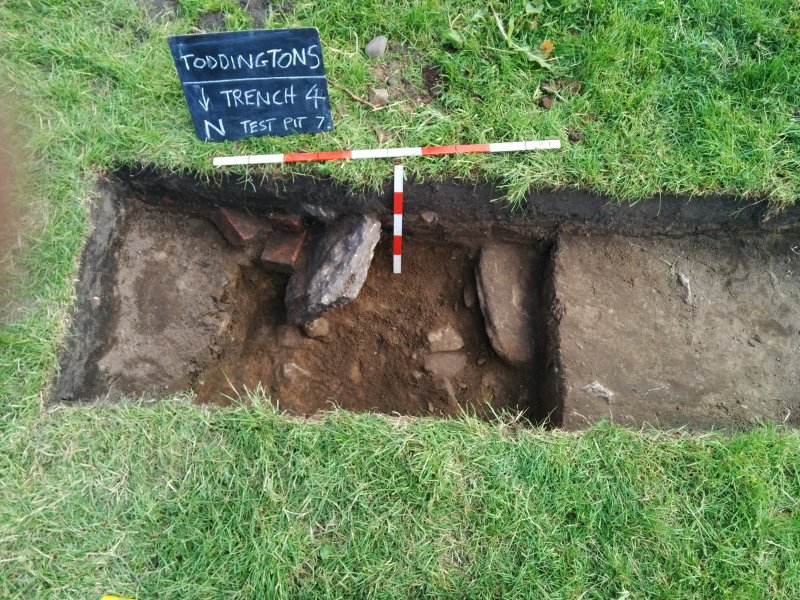
Date: 22nd March 2019
Just a quick visit, myself and Patrick, to check out the site – see if there is anything visible on the ground (and take more drone pics). After measuring out where we expected to find the well (21.7m from the bottom field boundary), we could detect a slight depression in the field. Nothing else visible except a thin scatter of large stones, a small mound and, worryingly, a large lump of concrete.

